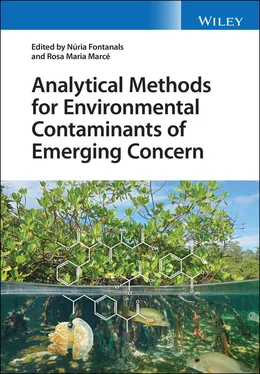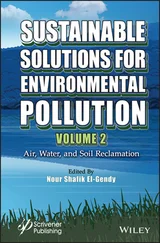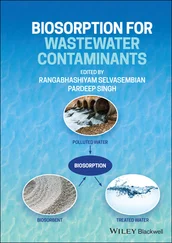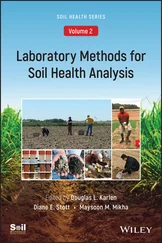Analytical Methods for Environmental Contaminants of Emerging Concern
Здесь есть возможность читать онлайн «Analytical Methods for Environmental Contaminants of Emerging Concern» — ознакомительный отрывок электронной книги совершенно бесплатно, а после прочтения отрывка купить полную версию. В некоторых случаях можно слушать аудио, скачать через торрент в формате fb2 и присутствует краткое содержание. Жанр: unrecognised, на английском языке. Описание произведения, (предисловие) а так же отзывы посетителей доступны на портале библиотеки ЛибКат.
- Название:Analytical Methods for Environmental Contaminants of Emerging Concern
- Автор:
- Жанр:
- Год:неизвестен
- ISBN:нет данных
- Рейтинг книги:5 / 5. Голосов: 1
-
Избранное:Добавить в избранное
- Отзывы:
-
Ваша оценка:
- 100
- 1
- 2
- 3
- 4
- 5
Analytical Methods for Environmental Contaminants of Emerging Concern: краткое содержание, описание и аннотация
Предлагаем к чтению аннотацию, описание, краткое содержание или предисловие (зависит от того, что написал сам автор книги «Analytical Methods for Environmental Contaminants of Emerging Concern»). Если вы не нашли необходимую информацию о книге — напишите в комментариях, мы постараемся отыскать её.
Provides the analytical methodology required to detect different families of organic compounds of emerging concern (CECs) from environmental samples Analytical Methods for Environmental Contaminants of Emerging Concern
Analytical Methods for Environmental Contaminants of Emerging Concern
Analytical Methods for Environmental Contaminants of Emerging Concern — читать онлайн ознакомительный отрывок
Ниже представлен текст книги, разбитый по страницам. Система сохранения места последней прочитанной страницы, позволяет с удобством читать онлайн бесплатно книгу «Analytical Methods for Environmental Contaminants of Emerging Concern», без необходимости каждый раз заново искать на чём Вы остановились. Поставьте закладку, и сможете в любой момент перейти на страницу, на которой закончили чтение.
Интервал:
Закладка:

Figure 2.1 Selected properties of pharmaceuticals.
2.1.2 Reported or Potential Metabolites and/or Transformation Products
During the last two decades many studies have been performed in order to evaluate their sources, occurrence, fate and effects on human health and other organisms [1, 2, 4–10]. Many different sources of their presence have been pointed out, including their inefficient removal in the wastewater treatment plants, husbandry, aquacultures, inappropriate drugs disposal, pharmaceutical industry etc. [1, 2, 4–10]. In general, after their application in human medicine or in veterinary use, pharmaceuticals undergo different processes leading to the excretion of their metabolites, which should usually be less active and more polar than native forms [1, 2]. In some cases, however, metabolism may lead to more active compounds, such as metabolites of carbamazepine, diclofenac, acetaminophen [11–14] or tamoxifen (hydroxyl-desmethyltamoxifen and 4-hydroxytamoxifen), which (these last two) can be up to 100 times more potent and active than the parent compound [15]. This in turn leads to the occurrence in the environment not only of their parent forms but also of their metabolites [11–14, 16]. However, it must also be taken into account that pharmaceuticals and their metabolites may undergo many different transformation processes in the waste water treatment plant, drinking water treatment processes or being present in the environment (such as hydrolysis, photodegradation and biodegradation), which can also lead to the production of many new additional degradation products of pharmaceuticals [11]. For example, glucuronide- and sulfate-conjugates (phase II metabolites) have been observed to be readily deconjugated during biological wastewater treatment to the active form of the pharmaceutical or its corresponding phase I metabolite [11]. All of these compounds, including metabolites and degradation products, are usually referred to as “transformation products (TPs)” in the scientific literature [11, 12, 14].
It must also be highlighted that the environmental fate of TPs can be different from the parent compound, meaning that the environmental compartments that are exposed to the parent compound may not be exposed to a TP [11]. While some of the TPs are known and have already been detected in the aquatic environment in concentrations higher than their parent compounds, the majority of TPs present there have not been identified yet [11]. The current state of knowledge on the presence of TPs in the environment has been quite recently presented [11–14, 16]. Based on these data, selected TPs have been presented in Table 2.1. Taking into consideration these data, it might be concluded that human and the environment are exposed to a highly variable and still not fully known cocktail of pharmaceuticals and their TPs.
2.1.3 Occurrence
In 2019 the German Environmental Agency (Umwelt Bundesamt) published the Final report on The database “Pharmaceuticals in the Environment” – Update and new analysis (Texte 67/2019). This is a summary of the state of knowledge on this problem [17]. It is based on the data published all over the world in 1,519 publications from peer-reviewed journals and 240 review papers from 1987 up to 2016. The analysis of these data revealed that pharmaceuticals and their transformation products have been detected in 75 countries, and in 54 different matrices worldwide. It was proved that 771 active pharmaceutical substances and their TPs have been measured globally, and 596 substances in the European Union. It must also be noted that most of these compounds have been detected in the effluents of wastewater treatment plants. In contrast, 528 substances were determined in surface water, groundwater and drinking water all over the world. However, 19 of them have been detected in all five United Nation regions [17]: 17-α-ethynylestradiol, 17-β-estradiol, acetylsalicylic acid, carbamazepine, ciprofloxacin, clofibric acid, diclofenac, estriol, estrone, ibuprofen, indomethacin, ketoprofen, naproxen, paracetamol, sulfamethazine, sulfamethoxazole, triclocarban, triclosan and trimethoprim.
In comparison with the previous version of these data five substances (indomethacin, ketoprofen, sulfamethazine, triclocarban and triclosan) have now been detected in all five UN regions [17]. Even though there have been more than 50 different matrices analysed, it has been proved that pharmaceutical residues were mostly found in groundwater, surface water and drinking water, as well as soil and sediments [17]. Moreover, it was also observed that the most commonly detected pharmaceuticals in surface water or wastewater worldwide belong to the group of antibiotics and analgesic/anti-inflammatories [1]. Usually, more than 40% of the analysed samples were positive for at least one target, with concentrations for half of them <0.1 μg L −1[1]. Furthermore, most of the published data on the Maximal Environmental Concentrations (MECs) come from China, USA, Spain and Germany [17].
In general, their concentrations are in the range of ng L −1up to μg L −1in the water bodies (wastewater, surface water, ground water and drinking water) and from μg kg −1up to mg kg −1in sludge/soils or sediments. In Figure 2.2 the range of pharmaceutical concentrations in different environmental samples has been presented based on the previously reviewed data in [1] and [17].
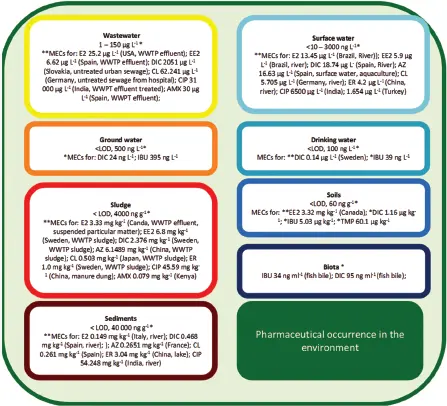
Figure 2.2 Pharmaceuticals occurrence in the environment. Average range of concentration based on the data presented in *[1], examples of MECs based on the data in **[17] (applied abbreviations: E2 – estradiol, EE2 – 17--estradiol, DIC – diclofenac, AZ – azithromycin, CL – clarithromycin, ER – erythromycin, CIP – ciprofloxacin, AMX – amoxicillin, IBU – ibuprofen, TMP – trimethoprim).
Table 2.1 Pharmaceuticals and their selected transformation products [12-14].
| Pharmaceutical (native form) | Therapeutic group | Excretion of parent form [%] | Main metabolites/ Transformation products | Justification | Additional comments |
| Carbamazepine (CBZ) | Antidepressant/antiepileptic | 5% | carbamazepine-10,11-epoxide(CBZ-Ep) | Active metabolite; however, unstable; can be transformed to Di-OH-CBZ, hence the concentration in the environment is usually lower than for Di-OH-CBZ; detected in the environment up to 4000 ng L −1. It is also a transformation product of CBZ in the process of water chlorination. Toxicity to V. fischeri is similar to the toxicity of parent form. | There were no losses in the water treatment processes in terms of the content of CBZ metabolites. In some cases, the amount of 2-OH-CBZ and Di-OH-CBZ increased after the purification process, which was most likely due to the fact that some CBZ and its metabolites are also excreted in the form of glucuronides. |
| 10,11-dihydro-trans-10,11-dihydroxy-carbamazepine(Di-OH-CBZ) | Not active, concentrations at the level of 4000 ng L −1, concentrations higher than for the native form. It is also a transformation product of CBZ in the process of water chlorination. More toxic to V. fischeri than the native substance. | ||||
| 2-hydroxycarbamazepine(2-OH-CBZ) | More toxic to V. fischeri than the native substance; detected in the environmental samples. | ||||
| 3-hydroxycarbamazepine(3-OH-CBZ) | More toxic to V. fischeri than the native substance; detected in the environmental samples. | ||||
| 10-hydroxycarbamazepine(10-OH-CBZ) | Often detected in environmental samples, more often than other metabolites, although the percentage of this metabolite is low, probably it is a TP of CBZ in WWTP purification processes. | ||||
| Metopropol (MTP) | β-blocker | <10% | metoprolol acid(MTPA), 60–65% | Detected in the environmental samples at concentrations 10 times higher than for the native form; this substance is also a product of the transformation of other beta-blockers, including atenolol, in the biodegradation process, hence its concentration is almost 10 times higher in effluents than in influents; acute toxicity to V. fischeri has not been demonstrated. | |
| α-hydroxymetoprolol (α-HMTP) | Detected, but only in wastewater, which is suspected to be due to the biodegradability of MTP in the water treatment process; acute toxicity to V. fischeri has not been demonstrated. | ||||
| O -desmethylmetoprolol ( O -DMTP) | MTP biodegradation product; however, it is rapidly biodegradable and therefore not detected in environmental samples. | ||||
| Sulfamethoxazole (SMX) | Antibiotic | 20% | N 4-acetylo-sulfamethoxazole ( N 4-Ac-SMX), 50–70% | Main metabolite of SMX. Excreted in 50–70%. Detected in the environmental samples. | |
| Ciprofloxacin (CIP) | 40–50% | CIP is the metabolite of enrofloxacin; metabolites of CIP are less active than CIP itself, moreover they are excreted in smaller amount that native form. | |||
| Metronidazol (METR) | 20% | hydroxymetronidazol (METR-OH), main metabolite | Active; in treated waters discharged from hospital treatment plants at a concentration of 11 µg L −1; although the concentrations in WWTP wastewater are lower (160 ng L −1). | ||
| Ibuprofen (IBU) | NSAIDs | 10–15% | 2-hydroxy-ibuprofen(2-OH-IBU), 26% | Concentration in influents 6840 ng L −1while in the effluents 1130 ng L −1; hydroxyl derivatives more toxic to V. fischeri than the native form. | It was found that these compounds are also produced as TPs in the biodegradation process of IBU. CX-IBU is removed by biodegradation, but OH-IBU is stable, therefore it is the dominant TP in purified waters, although there are studies where it has been found that both can be biodegradable – it depends on the test conditions. |
| carboxy-ibuprofen(CX-IBU), 43% | Concentration in influents 38.4 μg L −1while in the effluents 10.6 μg L −1. | ||||
| 1-hydroxy-ibuprofen(1-OH-IBU) | The percentage of this metabolite is lower than for others; this is reflected in its concentrations detected in wastewaters, lower than for 2-OH-IBU; however, hydroxyl derivatives are more toxic than the native form to V. fischeri . | ||||
| Diclofenac (DIC) | 5–10% | 4-hydroxydiclofenac(4-OH-DCF), main metabolite, 16% | Concentration in WWTP effluents at the level of 1600 ng L −1. | ||
| 5-hydroxydiclofenac(5-OH-DCF), 6,1% | Concentration in WWTP effluents at the level of 860 ng L −1. | ||||
| 4-hydroxydiclofenac dehydrate (4-OH-DCF-H 2O) | Concentration in WWTP effluents at the level of 660 ng L −1. | ||||
| Ketoprofen (KET) | 20% | glucuronide-KET 80% | Excreted mainly in the form of glucuronides, which are unstable, which leads to the formation of the native form. | ||
| Naproxen (NPX) | <1% | 6- O -desmethyl-naproxen (6- O -DMNPX) (<1%) | It is a metabolites, but it is also produced during the biodegradation process in WWTP. | ||
| NPX and 6- O -DMNPX excreted mainly as coniugates (66–92%) | |||||
| Tramadol (TRA) | Opioid painkiller | 30% | O -desmethyl-tramadol ( O -DMTRA) | Active metabolite. | |
| Fluoxatine (FLX) | Antidepressant | 11% | Norfluoxetine(NOR-FLX) | ||
| Venlafaxine (VNF) | 5% | O -desmethylvenlafaxine ( O -DM-VNF) | |||
| Estron (E1) | Steroid hormones | 2-hydroxyestrone (2-OH-E1) | Detected at very low concentrations (max. 14 ng L −1). | ||
| 4-hydroxyestrone (4-OH-E1) | Detected at very low concentrations (max. 14 ngL −1). | ||||
| Tamoxifen (TAM) | Anticancer drug | <30% | Hydroxytamoxifen (OH-TAM) | Active metabolite. | |
| endoxifen | Active metabolite. | ||||
| Cyclophosphamide (CF)/ ifosfamide (IF) | carboxyphosphamide | ||||
| 4-OH-cyclophosphamide/ 4-OH-ifosfamide | Active metabolites, but unstable. | ||||
| Methothrexate (MET) | 7-hydroxymethothrexate(7-OH-MET) | Active metabolite and TPs – it is produces during the MET biodegradation; however, it is stable. | |||
| Fenbendazole (FEN) | Antiparasites | fenbendazole sulfoxide(FEN-SO)oxfendazol (OXFEN) | Active metabolite. |
2.1.4 Legislation
Интервал:
Закладка:
Похожие книги на «Analytical Methods for Environmental Contaminants of Emerging Concern»
Представляем Вашему вниманию похожие книги на «Analytical Methods for Environmental Contaminants of Emerging Concern» списком для выбора. Мы отобрали схожую по названию и смыслу литературу в надежде предоставить читателям больше вариантов отыскать новые, интересные, ещё непрочитанные произведения.
Обсуждение, отзывы о книге «Analytical Methods for Environmental Contaminants of Emerging Concern» и просто собственные мнения читателей. Оставьте ваши комментарии, напишите, что Вы думаете о произведении, его смысле или главных героях. Укажите что конкретно понравилось, а что нет, и почему Вы так считаете.
